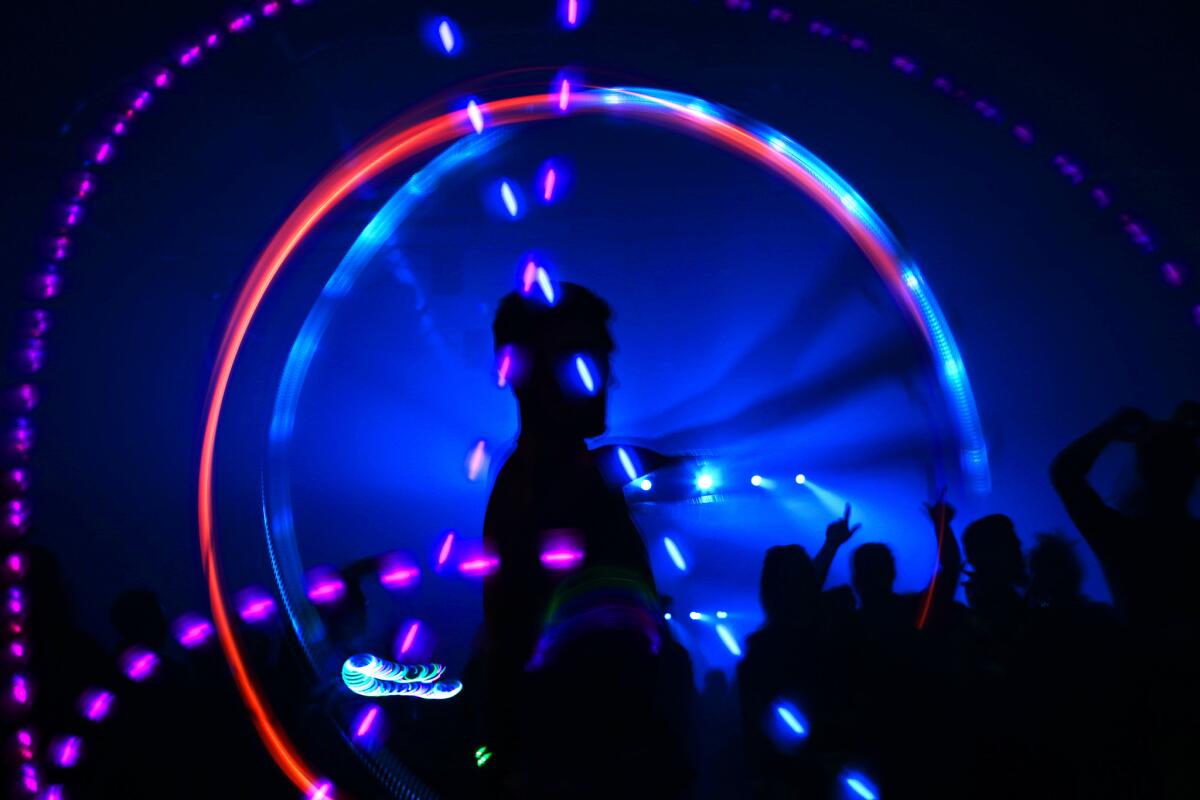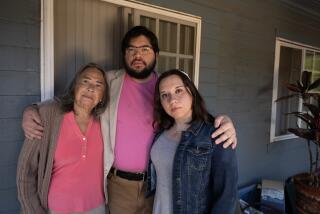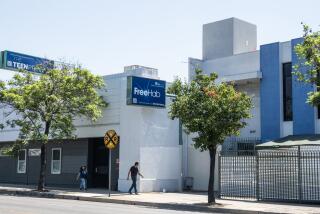After suspected drug overdose deaths, Fairplex has no plans to host raves in 2016

Cody Epperly, 22, of San Diego, center, at the Hard Day of the Dead rave at the Fairplex in Pomona over Halloween weekend.
- Share via
Seven months after two young women died of suspected drug overdoses after attending a rave concert at the fairgrounds, a spokeswoman for the Los Angeles County Fair Assn. said Tuesday that the group is not planning to host raves this year.
“We are not looking to host [electronic dance music] concerts or related events in 2016,” association spokeswoman Renee Hernandez said in an email to The Times, responding to a question. She did not immediately answer a follow-up question as to why the decision was made.
The statement comes as the association has come under increasing scrutiny over the raves sponsored by concert promoter Live Nation Entertainment.
The Los Angeles County coroner has ruled that the death of UCLA student Tracy Nguyen, 18, was caused by an overdose of the illegal drug Ecstasy. Officials have not ruled on the cause of death for Cal State Channel Islands student Katie Dix, 19.
Critics of the raves at the county fairgrounds in Pomona, also known as the Fairplex, welcomed the decision.
“This is a right step in the right direction,” said Mario Ramos, a member of the group Protect Our Neighborhood, formed to oppose the raves after they arrived at the Fairplex in 2014. “I just wish they made this decision a year and a half ago, prior to the deaths of the two women.”
Judy St. John, a retired teacher who lives near the Fairplex, said raves should not return.
“What about next year?” she asked. “It shouldn’t be just for the rest of the year, it should be no more, ever.”
A suspension of raves would mark a major reversal for the nonprofit that runs the fairgrounds on county-owned land.
In its 2014 annual report, the association touted its partnership with Live Nation and its Hard electronic dance music festival brand as “introducing the campus to a new audience and strengthening our claim as a popular SoCal entertainment destination.”
Representatives of Live Nation did not respond to requests for comment or to questions on where Hard Summer or Hard Day of the Dead will be held this year.
Drug overdoses have been a major problem at electronic dance music festivals, where the use of Ecstasy and similar substances is closely tied to the rave experience.
After the deaths of the two rave participants last summer, county Supervisor Michael D. Antonovich called the rave operator “irresponsible” and said, “If raves are only going to exist when drugs and alcohol are available, then they are no longer welcome in Los Angeles County’s facilities.” Supervisor Hilda Solis said, “No one should have to lose their life by attending a music event at one of our facilities.”
Last summer, 49 people at the Aug. 1-2 Hard Summer music festival had to be transported to emergency rooms by ambulance. Officials say that is a big number and highly unusual for a single event.
There have now been at least 21 confirmed drug-related deaths among people who went to raves nationwide by Los Angeles-area companies since 2006. Ten have died in Southern California, and five in the Las Vegas area.
The announcement that the fairgrounds operator was not looking to hold raves in 2016 came moments after the Board of Supervisors signaled its intent Tuesday to regulate gatherings of more than 10,000 people on county-owned land, which would cover raves at the Fairplex.
The supervisors said the county should have the authority to make certain demands of operators of large events, such as ordering additional security and requiring more first-aid stations. Failure to meet the county’s demands could result in an event not being allowed, the county counsel said.
Under the unanimous vote Tuesday, the supervisors directed county lawyers to draft an ordinance outlining these rules. A similar law is in place for state agencies.
The ordinance falls short of what the state-run Cow Palace near San Francisco opted to do in 2010: stop hosting raves, after that venue saw numerous drug-related overdoses and deaths.
Raves stopped being held at the Los Angeles Memorial Coliseum and Sports Arena in 2011, months after a 15-year-old girl who attended a rave died of an Ecstasy overdose.
Ecstasy can cause fatalities because it can trigger a sharp increase in body temperature to as high as 109 degrees — high enough to cause organ failure. Ravegoers are often told to drink plenty of water, but some drink too much, which can cause sodium levels to crash and trigger a seizure that makes it hard to breathe, leaving some people to fall into fatal comas.
The drug can also cause the breakdown of muscle into a chemical that damages the kidneys, which can be deadly.
Doctors have said overdosing ravegoers have come into the emergency room with convulsions and heart attacks, leaving some who survived with brain damage as well as impaired speech and walking ability.
The fair association has also been criticized by elected officials for how it operates. Last month, The Times reported that the association paid its chief executive, James Henwood Jr., more than $1 million in total compensation in 2014, the fifth straight year the organization reported financial losses.
State and county officials have ordered audits of the association. Officials at the association have defended the compensation practices as justified because of the complexity of the organization.
Twitter: @ronlin
Times staff writer Richard Winton contributed to this report.ALSO
L.A. county supervisors vote to study a ban on raves after latest deaths
More than $1 million paid to head of L.A. County Fair Assn. as financial losses mount
Readers React: Could better drug education have prevented two rave deaths?
More to Read
Sign up for Essential California
The most important California stories and recommendations in your inbox every morning.
You may occasionally receive promotional content from the Los Angeles Times.











